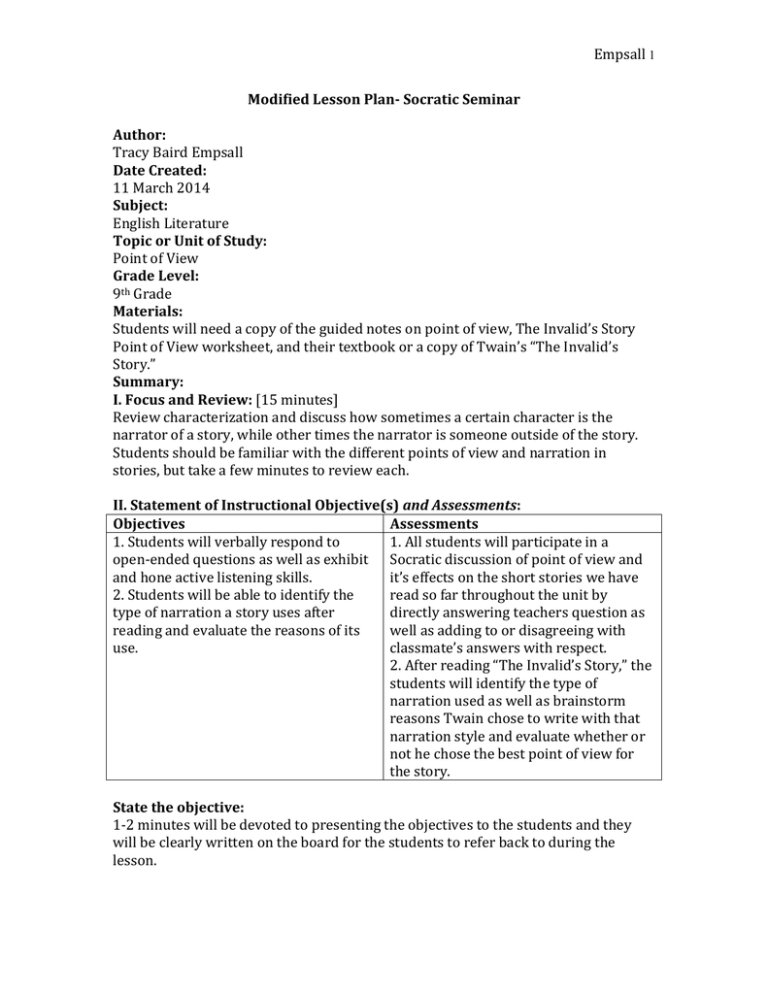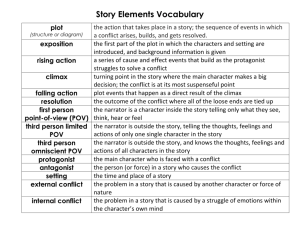Socratic Seminar - Elements of Short Stories
advertisement

Empsall 1 Modified Lesson Plan- Socratic Seminar Author: Tracy Baird Empsall Date Created: 11 March 2014 Subject: English Literature Topic or Unit of Study: Point of View Grade Level: 9th Grade Materials: Students will need a copy of the guided notes on point of view, The Invalid’s Story Point of View worksheet, and their textbook or a copy of Twain’s “The Invalid’s Story.” Summary: I. Focus and Review: [15 minutes] Review characterization and discuss how sometimes a certain character is the narrator of a story, while other times the narrator is someone outside of the story. Students should be familiar with the different points of view and narration in stories, but take a few minutes to review each. II. Statement of Instructional Objective(s) and Assessments: Objectives Assessments 1. Students will verbally respond to 1. All students will participate in a open-ended questions as well as exhibit Socratic discussion of point of view and and hone active listening skills. it’s effects on the short stories we have 2. Students will be able to identify the read so far throughout the unit by type of narration a story uses after directly answering teachers question as reading and evaluate the reasons of its well as adding to or disagreeing with use. classmate’s answers with respect. 2. After reading “The Invalid’s Story,” the students will identify the type of narration used as well as brainstorm reasons Twain chose to write with that narration style and evaluate whether or not he chose the best point of view for the story. State the objective: 1-2 minutes will be devoted to presenting the objectives to the students and they will be clearly written on the board for the students to refer back to during the lesson. Empsall 2 Assessment: Assessment 1 will be part of guided practice. Assessment 2 will be individual practice and will be due at the start of the next class. III. Teacher Input: [15 minutes] The teacher will give a brief review of the different types of point of view (which were discussed in detail during the previous poetry unit), and the students will follow along filling out their guided notes. See the guided notes to see the brief overview the teacher will present. The teacher will then instruct the students to form a large circle to sit in while conducting the Socratic Seminar. The teacher will present the questions and guide the discussion in the guided practice section. IV. Guided Practice: [30-40 minutes] Below are the seminar questions followed by answers the teacher should guide students to discussing as well as allowing other interpretations: Think back to Hawthorne’s “The Birthmark.” What type of narration was used? Omniscient. There are a few moments where the narrator throws out his omniscience: “We know not whether Aylmer possessed this degree of faith in man's ultimate control over Nature” (1). Why do you think Hawthorne did this? This is such an interesting line, because the narrator confesses that he is in fact ignorant of all the facts. It's odd, because for most of the narrative he maintains omniscience, with access to both Aylmer and Georgiana's thoughts. It's possible that Hawthorne is making a point about the limitations of human knowledge. The POV of Connell’s “The Most Dangerous Game” allows us to see it as a story of transformation of perspective. How so? He begins by having no sympathy with animals—or prey—and ends up experiencing precisely what the prey does when being hunted. But Rainsford can be a little frustrating as a narrative voice. Even though he openly agrees that humans should be excused from the horrors of that experience (which Zaroff thinks is a “romantic idea about the value of human life”), he doesn't reflect upon his original view at end after all he has experienced. In fact, he ends up killing the predator and repeating the very actions he condemned earlier, which was killing humans. Saki’s "The Interlopers" is written from the third-person omniscient point of view; what does this add to the story? This point of view allows the narrator to present the history of the disputed land, explain how the similar personalities of Georg and Ulrich have brought the feud to a murderous brink, and explain the moral codes that govern the enemies. Each man's perception of the events that have taken place are presented. Access to the thoughts and feelings of both men alerts the reader that the two are actually more alike than different, which further unites the men in their futile feud and even more futile impending death. Empsall 3 How do you think you would feel as a reader if Ulrich or George told the story? What if it was nature that told the story? Why do you think London used an omniscient narrator? There are two main reasons the narrator of this story is omniscient instead of limited: first, the narrator not only tells us what the man is thinking, but contrasts it with what the dog is thinking, like in the following quote: "[The dog] knew that it was no time for traveling. Its instinct told it a truer tale than was told by the man's judgment" (6). Burn. Take that, unnamed man. Second, the narrator shows its omniscience by actually stepping in and judging the man pretty harshly. It's not as bad as what you sometimes find in high school hallways, but still pretty judgmental. We get a clear idea of this in paragraph three, where the narrator tells us that "The trouble with [the man] was that he was without imagination. He was quick and alert in the things of life, but only in the things, and not in the significance" (3). The story would be quite different if the narrator didn't butt in on our reading like this. We might actually sympathize with the man a lot more. Instead, we get this pushy narrator telling us not to get too attached to this guy because he just might be a bit of an idiot. The narrator is also the only thing that gives us an insight into the difference between the man and the dog's responses to the cold weather and nature in general: "To permit the ice to remain would mean sore feet. [The dog] did not know this. It merely obeyed the mysterious prompting that arose from the deep crypts of its being. But the man knew, having reached a judgment on the subject" (13). Passages like these show us why humans can be pretty pathetic compared to dogs, since while the man can "know" things, there's only so much he can be aware of through experience. The reason he winds up perishing in the arctic tundra is because when it comes to traveling in seventy-five below zero, you might only get one shot at survival, with no experience to rely on. Only instinct can save you. Critics of Hemmingway have said he “takes the fly-on-the-wall technique” to an extreme in “Hills Like White Elephants.” What do you think they mean by this? The third-person narrator takes the fly-on-the-wall technique to extremes in "Hills Like White Elephants." We can see both the journalist and the storyteller in Hemingway working together to construct the story. The journalist side doesn’t tell us what the characters are thinking, only what they do, see, and most importantly, what they say. The journalist also provides a bare minimum of context: the scenery (Spain, the river Ebro, some white hills), the weather (hot), and the train schedules. V. Closure: [5 minutes] While still in the discussion circle, invite students to share the point of view they are thinking will work best of their original short stories. Empsall 4 VI. Independent Practice: [homework] The students were to have read Twain’s “The Invalid’s Story.” They are to finish the short worksheet for homework. STANDARDS: 9-1.RL.1 Cite strong and thorough textual evidence to support analysis of what the text says explicitly as well as inferences drawn from the text. 9-10.RL.5 Analyze how an author’s choices concerning how to structure a text, order events within it (e.g., parallel plots), and manipulate time (e.g., pacing, flashbacks) create such effects as mystery, tension, or surprise. 9-10.RL.6 Analyze a particular point of view or cultural experience reflected in a work of literature from outside the United States, drawing on a wide reading of world literature. 9-10.RL.10 By the end of grade 9, read and comprehend literature, including stories, dramas, and poems, in the grades 9-10 text complexity band proficiently, with scaffolding as needed at the high end of the range. By the end of grade 10, read and comprehend literature, including stories, dramas, and poems, at the high end of the grades 9-10 text complexity band independently and proficiently. 9-10.W.1 Write arguments to support claims in an analysis of substantive topics or texts, using valid reasoning and relevant and sufficient evidence. 9-10.W.2 Write informative/explanatory texts to examine and convey complex ideas, concepts, and information clearly and accurately through the effective selection, organization, and analysis of content. 9-10.SL.1 Initiate and participate effectively in a range of collaborative discussions (one-on-one, in groups, and teacher-led) with diverse partners on grades 9–10 topics, texts, and issues, building on others’ ideas and expressing their own clearly and persuasively. 9-10.SL.3 Evaluate a speaker’s point of view, reasoning, and use of evidence and rhetoric, identifying any fallacious reasoning or exaggerated or distorted evidence. 9-10.SL.6 Adapt speech to a variety of contexts and tasks, demonstrating command of formal English when indicated or appropriate. Plans for Individual Differences: Discussing different levels of text allows for differentiation throughout the lesson. The academic range of questions also allows for this, as well as the opportunity for students to participate at varying levels during the discussions. References: Leiter, Kelly (2012). Different Types of Point of View. The Beginning Writer. Retrieved from http://www.thebeginningwriter.com/2012/03/look-at-differenttypes-of-point-of.html Empsall 5 Guided Notes (Teacher Version) POINT OF VIEW Think back to our last unit when we discussed point of view (POV) in writing. The point of view you choose for your story is going to be very important because it will help you determine what information your readers will have access to. First person is used when the main character is telling the story. This is the kind that uses the "I" narrator. As a reader, you can only experience the story through this person's eyes. So you won't know anything about the people or events that this character hasn't personally experienced First Person Peripheral is when the narrator is a supporting character in the story, not the main character. It still uses the "I" narrator but since the narrator is not the protagonist, there are events and scenes that will happen to the protagonist that the narrator will not have access to. _________________________________________________________________________________________________ Second person POV is generally only used in instructional writing. It is told from the perspective of "you". _________________________________________________________________________________________________ Third person POV is used when your narrator is not a character in the story. It uses the "he/she/it" narrator and it is the most commonly used point of view in writing. There are 3 main types: Third Person Limited means that the POV is limited to only one character. Which means that the narrator only knows what that character knows. With third person limited you can choose to view the action from right inside the character's head, or from further away, where the narrator has more access to information outside the protagonist's viewpoint. Third Person Multiple is still in the "he/she/it" category, but now the narrator can follow multiple characters in the story. The challenge is making sure that the reader knows when you are switching from one character to another. Third Person Omniscient POV still uses the "he/she/it" narration but now the narrator knows EVERYTHING. The narrator isn't limited by what one character knows, sort of like the narrator is God. The narrator can know things that others don't, can make comments about what's happening, and can see inside the minds of other characters. _________________________________________________________________________________________________ Empsall 6 Guided Notes (Student Version) POINT OF VIEW Think back to our last unit when we discussed point of view (POV) in writing. The point of view you choose for your story is going to be very important because it will help you determine what information your readers will have access to. _________________________ is used when the main character is telling the story. This is the kind that uses the_____________________________. As a reader, you can only experience the story through this person's eyes. So you won't know anything about the people or events that this character hasn't personally experienced. ____________________________________________ is when the narrator is a supporting character in the story, not the main character. It still uses the __________________________ but since the narrator is not the protagonist, there are events and scenes that will happen to the protagonist that the narrator _____________________ have access to. _________________________________________________________________________________________________ _________________________________ POV is generally only used in _________________________________. It is told from the perspective of "you". _________________________________________________________________________________________________ _____________________________ POV is used when your narrator is not a character in the story. It uses the "he/she/it" narrator and it is the ________________________ point of view in writing. There are 3 main types: _______________________________ means that the POV is limited to only one character. Which means that the narrator only knows _________________________________________. With ____________________________ you can choose to view the action from right inside the character's head, or from further away, where the narrator has more access to information outside the protagonist's viewpoint. __________________________________ is still in the "he/she/it" category, but now the narrator can follow _______________________________ in the story. The challenge is making sure that the reader knows when you are switching from one character to another. _________________________________ POV still uses the ________________narration but now the narrator knows _________________________. The narrator isn't limited by what one character knows, sort of like the narrator is God. The narrator can know things that Empsall 7 others don't, can make comments about what's happening, and can see inside the minds of other characters. _________________________________________________________________________________________________ Worksheet A The Invalid’s Story By Mark Twain Answer the questions about the story’s point of view in complete sentences and fill the space. If you need more space, please continue on the back. 1. What point of view is the story written in? _________________________________________________________________________________________________ 2. Why do you think it is written like this? ______________________________________________________________________________________ _________________________________________________________________________________________________ _________________________________________________________________________________________________ _________________________________________________________________________________________________ _________________________________________________________________________________________________ _________________________________________________________________________________________________ 3. Pick a different POV and tell how the story would change. Would it be better? Worse? ______________________________________________________________________________________ _________________________________________________________________________________________________ _________________________________________________________________________________________________ _________________________________________________________________________________________________ _________________________________________________________________________________________________ _________________________________________________________________________________________________ ______________________________________________________________________________________ Empsall 8 _________________________________________________________________________________________________ _________________________________________________________________________________________________





